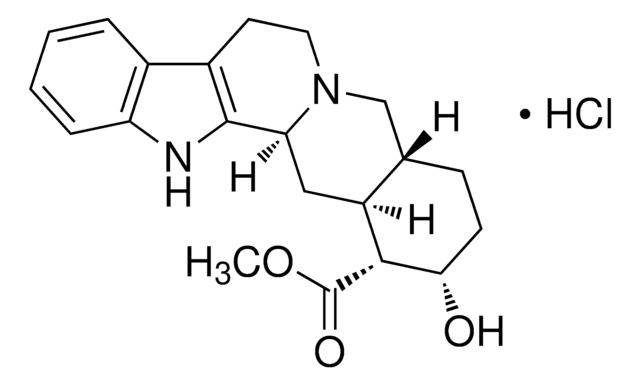P7791
Prazosin hydrochloride
≥99.0% (HPLC), powder, α1-adrenoceptor antagonist
Synonyme(s) :
1-(4-Amino-6,7-dimethoxy-2-quinazolinyl)-4-(2-furanylcarbonyl)piperazine hydrochloride, Furazosin hydrochloride
About This Item
Produits recommandés
product name
Prazosin hydrochloride, ≥99.0% (HPLC)
Pureté
≥99.0% (HPLC)
Forme
powder
Solubilité
H2O: 0.5 mg/mL
methanol: 6 mg/mL
dilute aqueous acid: insoluble
Chaîne SMILES
Cl.COc1cc2nc(nc(N)c2cc1OC)N3CCN(CC3)C(=O)c4ccco4
InChI
1S/C19H21N5O4.ClH/c1-26-15-10-12-13(11-16(15)27-2)21-19(22-17(12)20)24-7-5-23(6-8-24)18(25)14-4-3-9-28-14;/h3-4,9-11H,5-8H2,1-2H3,(H2,20,21,22);1H
Clé InChI
WFXFYZULCQKPIP-UHFFFAOYSA-N
Informations sur le gène
human ... ADRA1A(148) , ADRA1B(147) , ADRA1D(146)
Vous recherchez des produits similaires ? Visite Guide de comparaison des produits
Description générale
Application
- to block the α1adrenergic receptors that mediate sympathetic vasoconstriction in mice
- as an α1-adrenoceptor blocker,administered intragastrically in rats
- as a vasodilator,administered together with inuslin into the left ventricle of mice for the assessment of its effects on renal functions
Actions biochimiques/physiologiques
Caractéristiques et avantages
Conditionnement
Attention
Mention d'avertissement
Warning
Mentions de danger
Conseils de prudence
Classification des risques
Repr. 2 - STOT RE 2 - STOT SE 3
Organes cibles
Central nervous system
Code de la classe de stockage
11 - Combustible Solids
Classe de danger pour l'eau (WGK)
WGK 3
Point d'éclair (°F)
Not applicable
Point d'éclair (°C)
Not applicable
Équipement de protection individuelle
dust mask type N95 (US), Eyeshields, Gloves
Certificats d'analyse (COA)
Recherchez un Certificats d'analyse (COA) en saisissant le numéro de lot du produit. Les numéros de lot figurent sur l'étiquette du produit après les mots "Lot" ou "Batch".
Déjà en possession de ce produit ?
Retrouvez la documentation relative aux produits que vous avez récemment achetés dans la Bibliothèque de documents.
Les clients ont également consulté
Articles
Gain a deeper understanding of the various types of receptor agonists and antagonists, including full, partial, and inverse agonists and competitive/reversible and non-competitive/irreversible antagonists.
Review alpha 1 adrenoceptors as well as their agonists, antagonists, and tissue expression patterns. We suggest several modulators and alternatives for working with a-1 adrenoreceptors.
Learn about alpha-2 adrenoceptor and its subtypes, mediated responses, and applications of agonists. Included is a list of available products and a comparison table.
Discover Bioactive Small Molecules for ADME/Tox
Notre équipe de scientifiques dispose d'une expérience dans tous les secteurs de la recherche, notamment en sciences de la vie, science des matériaux, synthèse chimique, chromatographie, analyse et dans de nombreux autres domaines..
Contacter notre Service technique















